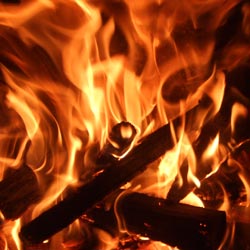WHMIS labels will help identify the product and alert users of the hazards, and how to properly use the product.
The Material Safety Data Sheet will provide more information about each dangerous substance. l Name of chemical
l The WHMIS hazard symbols
l Risks and precautions
l First aid instructions
l Supplier’s name and address
l Reference to the matching Material Safety Data Sheet
Labels and hazards
 Class A- Compressed Gas
Class A- Compressed GasCompressed gases are hazardous because they are under high pressure and the gas itself can be hazardous too. The bottle may explode if it is dropped or hit strongly.
These containers should be kept away from heat and store in designated areas.
Examples of compressed gas: steel cylinders of ethylene oxide, propane, oxygen, etc.
 Class B- Flammable and Combustible Materials
Class B- Flammable and Combustible MaterialsThese are items that will burn at a low temperature (Flammable = >37.8 degrees Celsius and Combustible = between 37.8 – 93.3 degrees Celsius).
If these materials come into contact with water or air, it could also cause them to burn.
Sub divisions:
Division 1: Flammable Gas – hydrogen, methane
Division 2: Flammable Liquid – gasoline, ethanol, methanol
Division 3: Combustible Liquid – diesel fuel
Division 4: Flammable Solid – sodium, magnesium
Division 5: Flammable Aerosol – butane, propane
Division 6: Reactive Flammable Material – lithium (in air), sodium (in water)
Class C- Oxidizing Materials
Has a risk of fire or explosion when near flammable and combustible material.
Wear protective equipment when handling these items.
Examples: Hydrogen peroxide, bleach
Class D- Poisonous and Infectious Material
These materials have are poisonous and could be fatal. It can also cause permanent damage if inhaled, swallowed or absorbed through skin.
Division 1: Immediate and Serious Toxic Effects
Contain materials that can have immediate impact on life and health
Examples: Formaldehyde, carbon monoxide, cyanide
Division 2: Other Toxic Effects
These materials are poisonous but will not cause immediate damages. Repeated exposure can result in death or permanent damage.
Examples: Examples: Asbestos, lead, mercury
Division 3: Biohazardous Infectious Material
Organisms like bacteria and viruses and toxins that may cause diseases fall under this category.
Examples: salmonella, AIDS virus,
Class E: Corrosive Material
Acids or caustic materials that will corrode metal and eat through skin are corrosive materials.
Examples: household cleaners, sulfuric acid, hydrogen chloride
Class F: Dangerous Reactive Materials
These substances will react dangerous when heated, pressured, or come into contact with water.
Examples: Ethylene oxide, ozone
International Safety Symbols:
 |
| International Safety Symbol |
An octagon represents DANGER and indicates very harmful substances
A diamond means a moderate level of danger or “warning.”
A triangle indicates caution and represents the least dangerous materials.
Safety Rules For Labs:
l Do not begin the experiment without the teachers permission
l Read instructions carefully and make sure you understand everything before starting the experiment
l Always wear safety goggles and keep them on at all times
l Do not eat or drink in the lab
l Waft substances to smell them, don’t inhale
l Report spills and other injuries to teacher
l Make sure hands are dry when handling electric materials
l Always wash hands after the experiment and clean up
What to do with Injuries:
Burns – run under cold water for 15 minutes
Cuts – put pressure on cut
Faints – keep the person lying down
Chemicals in eye – Wash with running water for 15 minutes
Poisoning – identify the poison
Chemical on skin – wash in water for 15 minutes
























